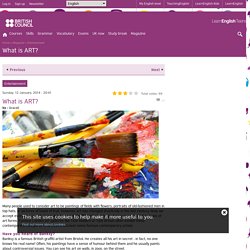

What is ART? Upper Intermediate English Listening - Banksy. Banksy is a controversial contemporary British artist and illustrator. This video quiz about an exhibition of his work will help you practise your English listening skills. Task 1 - First Listening Click on the play button in the centre of the screen to watch the video. Listen to get the main idea of what the video is about, the first time you watch it. Task 2 - Dictionary Skills Activity Here is a list of English words and expressions from the video. Use a dictionary to find the meaning of any new words and phrases. • museum• reception• traditional • institution• burnt out • exhibit• display (noun) • depiction• installation• landmark• guerilla • mainstream• sell out Task 3 - Listening Comprehension Watch the video again to find the answers to questions 1 - 10. If you get stuck on any of the questions, watch the video again to help you with the answers.
English For Life in The UK - The Fourth Plinth. The history of graffiti. The first drawings on walls appeared in caves thousands of years ago.

Later the Ancient Romans and Greeks wrote their names and protest poems on buildings. Modern graffiti seems to have appeared in Philadelphia in the early 1960s, and by the late sixties it had reached New York. The new art form really took off in the 1970s, when people began writing their names, or ‘tags’, on buildings all over the city. In the mid seventies it was sometimes hard to see out of a subway car window, because the trains were completely covered in spray paintings known as ‘masterpieces’. 74 FREE ESL Art worksheets. Graffiti: crime or culture? When you say the word “graffiti”, some people think of big, beautiful and colourful artwork whilst others think of mess that make our towns and cities look untidy and badly-maintained.

Graffiti is art that is painted on walls and other public places. It is most often made with spray paint, which comes in a can. However, graffiti can be made with any type of paint or other material. Some people use real paint to make their art. What is ART? Many people used to consider art to be paintings of fields with flowers, portraits of old-fashioned men in top hats, or pictures of bowls of fruit.

However, art has changed drastically in the last century. Now, we accept everything as art. Computer game art, graffiti and video projections are accepted as types of art forms. Famous London art galleries like Tate Modern or Tate Britain often exhibit these contemporary categories of art. Let's discover some famous contemporary artists: Have you heard of Banksy? Have you heard of Hirst? Have you heard of Duchamp? The history of graffiti. The first drawings on walls appeared in caves thousands of years ago.

Later the Ancient Romans and Greeks wrote their names and protest poems on buildings. Modern graffiti seems to have appeared in Philadelphia in the early 1960s, and by the late sixties it had reached New York. The new art form really took off in the 1970s, when people began writing their names, or ‘tags’, on buildings all over the city. In the mid seventies it was sometimes hard to see out of a subway car window, because the trains were completely covered in spray paintings known as ‘masterpieces’. In the early days, the ‘taggers’ were part of street gangs who were concerned with marking their territory. The debate over whether graffiti is art or vandalism is still going on. For decades graffiti has been a springboard to international fame for a few. Tattoos and piercings. Hello, everyone, and welcome back to another video for the British Council’s LearnEnglish Teens website and their YouTube channel.

In today’s video I wanted us to discuss the topic of tattoos and piercings, and, more specifically, whether they are seen as taboos in your society. Now, a taboo is something which usually has a negative connotation. It’s sometimes even forbidden from a society or a group because of the bad associations that are connected with it. Now, in Britain, in the 19th century, tattoos and piercings were actually seen as a taboo. A lot of the people who had these were either sailors, pirates, criminals, prisoners and people of a lower social class, so they were seen to be rebellious and going against the norms in society.
But now we’re living in the 21st century and that has all changed. I personally don’t have any tattoos, but when I was a little bit younger I had quite a lot of piercings. I’m very interested to hear what you all have to say on the topic. Радіо Свобода - Леонардо да Вінчі. What is Art?